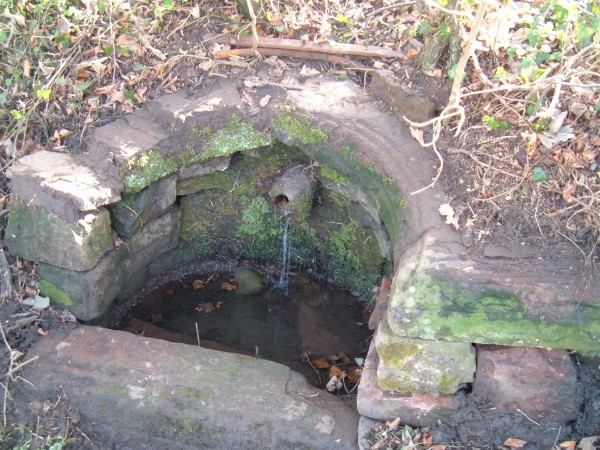Wells, Pumps and Water Supply.
The water supply to the bottom village appears originally to be from the spring situated on the roadside opposite Hill House. At what date the spring water supply was replaced by a hand pump situated in the lane between the rows of back-to-back houses in the bottom village, I don't know. This of course was much later replaced by mains water from Blackwell. The Cotton Mill, Print-Works, Dye-Works and the Corn Mill, all used the mill stream for their water supply for power, via water wheels, and for many of the processes. I know from and accident report in 1856, that a water pump existed in the print works yard, and I suspect that one also existed in the cotton mill yard.

The spring situated on the hill opposite Hill House, it's thought the spring originates as a watering place on the cattle droving route.
In High Cummersdale several Wells existed supplying what houses there was. One of the Wells was situated in the area where Margery Terrace now stands. There was a wall running the full length of where Margery Terrace now stands known by locals as the "Wellie Wall". On the opposite side of the road between the school and whats left of the Pump Lane buildings was another Well. I was informed many years ago by Mr John Ryan snr , that it was known as "Satan's Well" because of the noises that came from it. It was recorded in the parish council minutes of October, 1899 that "Pegg's Well" supplied a great part of the village at one time, however, the exact location of the well wasn't given. In the garden of the pensioners bungalow next to the farm entrance is an ornate Well covered over. Another Well exists in the garden of the first house as you enter the village, 'Garthside'. Pumps seem to have been replaced the Wells, although I only know of the one pump in High Cummersdale, that was situated at the head of Pump Lane near to the foot path stile to Carlisle.

The Pump at the head of Pump Lane.
During a complaint at the parish council meeting in 1895, we learn it little more about the water supply when the quality of the water in the drinking trough beside the village pump was mentioned. Mr Tom Jordan, complained that the water in the trough had a bad smell and had the colour of Irish Whiskey.
The 1899 parish council meeting discussed at length the water supply. It transpired that Stead McAlpin got their drinking water supply by boring down to water bearing gravel. Mr Dalton who owned the Cotton Mill and the Corn Mill and several houses owned two Pumps.